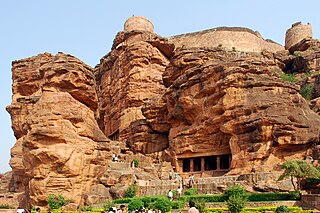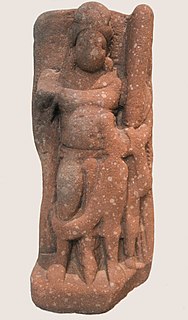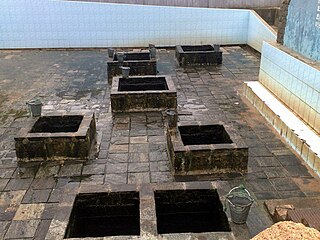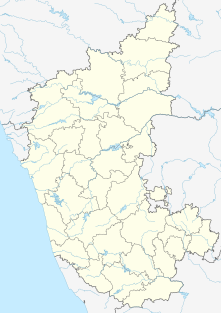
Shravanabelagola is a town located near Channarayapatna of Hassan district in the Indian state of Karnataka and is 144 km from Bangalore. The Gommateshwara Bahubali statue at Shravanabelagola is one of the most important tirthas in Jainism, one that reached a peak in architectural and sculptural activity under the patronage of Western Ganga dynasty of Talakad. Chandragupta Maurya is said to have died here in 298 BCE after he became a Jain monk and assumed an ascetic life style.

Kubera also known as Kuvera or Kuber, is the Lord of Wealth and the god-king of the semi-divine Yakshas in Hindu mythology. He is regarded as the regent of the North (Dik-pala), and a protector of the world (Lokapala). His many epithets extol him as the overlord of numerous semi-divine species and the owner of the treasures of the world. Kubera is often depicted with a plump body, adorned with jewels, and carrying a money-pot and a club.

Yaksha are a broad class of nature-spirits, usually benevolent, but sometimes mischievous or capricious, connected with water, fertility, trees, the forest, treasure and wilderness. They appear in Hindu, Jain and Buddhist texts, as well as ancient and medieval era temples of South Asia and Southeast Asia as guardian deities. The feminine form of the word is yakṣī or Yakshini.

Kumara Vyasa is the pen name of Narayanappa, an influential and classical, early 15th century poet in the Kannada language. His pen name is a tribute to his magnum opus, a rendering of the Mahabharata in Kannada. Kumara Vyasa literally means "Little Vyasa" or "Son of Vyasa". He was the contemporary and archrival of the famous, Veerashaiva, poet laureate Chamarasa who wrote the seminal work Prabhulingaleele covering the lives of Allama Prabhu and other Shiva Sharanas, circa 1435. Both poets worked in the court of Deva Raya II.

Badami, formerly known as Vatapi, is a town and headquarters of a taluk by the same name, in the Bagalkot district of Karnataka, India. It was the regal capital of the Badami Chalukyas from AD 540 to 757. It is famous for its rock cut structural temples. It is located in a ravine at the foot of a rugged, red sandstone outcrop that surrounds Agastya lake. Badami has been selected as one of the heritage cities for HRIDAY - Heritage City Development and Augmentation Yojana scheme of Government of India.

Bangalore Urban is a district of the Indian state of Karnataka. It is surrounded by the Bangalore Rural district on the east and north, the Ramanagara district on the west and the Krishnagiri district of Tamil Nadu on the south. Bangalore Urban district came into being in 1986, with the partition of the erstwhile Bangalore into Bangalore Urban and Bangalore Rural districts. Bangalore Urban has five taluks: Yelahanka, Bangalore North, Bangalore East, Bangalore South and Anekal. The city of Bangalore is situated in the Bangalore Urban district. The district has 17 hoblies, 668 villages and 9 municipal corporations. Electronics City is situated in Anekal Taluk.

Khatushyam is a temple situated in sikar district of Rajasthan,India. In Hinduism, Khatushyam is a name and manifestation of Barbaric, grandson of Bhima and son of Mata Ahilyavati. This manifestation is especially popular in the Indian state of Rajasthan and Haryana. The original Sanskrit name Barbarīka is often replaced in Rajasthan by the Hindi version, Barbarīk, often written as Barbareek.
In Hinduism, Alaka, which is also sometimes called Alakapuri, is a mythical city. It is the home of Kubera, the king of Yakshas and the lord of wealth, and his attendants, called yakshas. The Mahabharata mentions this city as the capital of the Yaksha Kingdom. This city rivals the capital of Indra the king of the Devas in its architecture, opulence, and overall splendor. It is quoted in the famous lyrical poem Meghadūta by Kalidasa

Sirsi is a hill station populated with 62,882 people in the Indian state of Karnataka and it is home to Elephants, Tigers, Leopard and unique Black panther. Sirsi was also known as Kalyanapattana during the Sonda Dynasty.This town is surrounded by thick green forest & many water falls. Hubli being the nearest city, business opportunities are plenty. Growing Arecanut or betel nut is the main occupation of the people. People own areca farms in acres & are satisfying the needs of the people all over India & abroad. Sirsi - is a tranquil town, dotted with terracotta-tiled houses, Jain Basadis (temples) and ancient Hindu temples. The 16th Century Marikamba Temple enshrines a wooden deity that is believed to have been found in a tank. Once in every two years, the temple celebrates Marikamba jatra (festival) in tribute to Goddess Marikamba.The Nearest international airport is Dabolim Airport, Goa

Yaksha Kingdom refers to the territory of a tribe of mythical creatures called Yakshas who were one of the Exotic Tribes of Ancient India and ancient Sri Lanka. They had kinship with another more ferocious tribe, the Rakshasas. The King of Yakshas, Vaisravana and the Rakshasa king, Ravana, were both sons of the sage Visrava Paulastya from two different wives. Kubera is sometimes mentioned as a Rakshasa king. Kubera ruled a Yaksha kingdom of enormous wealth. Pandavas visited this place during their forest life with the help of the Rakshasa Ghatotkacha and his friends.

The Katas Raj Temples, also known as Qila Katas, is a complex of several Hindu temples connected to one another by walkways. The temple complex surrounds a pond named Katas which is regarded as sacred by Hindus. The complex is located in the Potohar Plateau region of Pakistan's Punjab province. The temples are located near the town of Kallar Kahar, and are near the M2 Motorway.

The Aranmula Parthasarathy Temple is one of the "Divya Desams", the 108 temples of Vishnu revered by the 12 poet saints, or Alwars located near Aranmula, a village in Pathanamthitta District, Kerala, South India. Constructed in the Kerala style of architecture, the temple is glorified in the Divya Prabandha, the early medieval Tamil canon of the Azhwar saints from the 6th–9th centuries AD. It is one of the 108 Divyadesam dedicated to Krishna, an avatar of Vishnu, who is worshipped as Parthasarathy. The nearest railway station to the temple is located in Chengannur, while the nearest airport is Trivandrum International Airport.

Panchakuta Basadi is a temple complex located in the Kambadahalli village of the Mandya district, Karnataka state, in southwestern India. It is one of the finest examples of South Indian Dravidian architecture of the Western Ganga variety, related to the Jain faith and iconography. According to the historian K.R. Srinivasan, the temple complex, which was built by the kings of the Western Ganga Dynasty is assignable to the period 900–1000 CE. The historian I. K. Sarma however assigns an earlier date of 8th century, based on traces of early Pallava-Pandya and Chalukya-Pallava influences. Kambadahalli which is located 18 km from the famous Jain heritage town of Shravanabelagola, on the Mandya-Shravanabelagola highway, gets its name from the Brahmadeva pillar (Manasthambha) erected in front of the temple complex. From inscriptions, it is known that the temple complex has been renovated during later centuries, including the during the rule of the Hoysala Empire. The monument is protected by the Archaeological Survey of India as a "national monument". Srinivasan describes it as a "landmark in South India architecture".
Karyala is a village and union council, an administrative subdivision, of Chakwal District in the Punjab Province of Pakistan. It is part of Chakwal Tehsil. The village stands on the top of the Surla hills. This part of the country is known as Dhani meaning rich. A few kilometres away are the Khewra Salt Mines, which are some of the oldest in the world, and coal mines of Dandot.

Kuknoor is a City and Taluka in the Koppal District. It is located about 40 km from Hospet and 7 km from Mahadeva Temple (Itagi), Kuknoor is renowned for its temples of the Rastrakutas and Chalukyas times, of these the Navalinga group of temples is famous.
Pazhoor Perumthrikkovil is a Temple of Lord Shiva of Hindu tradition located at the town of Piravom, Ernakulam district, Kerala, India.

Manibhadra is one of the major yakshas. He was a popular deity in ancient India.

Akkana Basadi is a Jain temple built in 1181 A.D., during the rule of Hoysala empire King Veera Ballala II. The basadi was constructed by the devout Jain lady Achiyakka, wife of Chandramouli, a Brahmin minister in the court of the Hoysala king. The main deity of the temple is the twenty-third Jain Tirthankar (saint) Parshwanath. The temple is protected as a monument of national importance by the Archaeological Survey of India.

The Kanniya Hot Springs is a site with hot wells located in Trincomalee, Sri Lanka. There are seven wells in a square shape. Wells are only 3–4 feet deep and you can clearly see the bottom. The temperature is considerably high but vary slightly from one spring to another. Wells run out of water, when 10-15 buckets of water are taken out.



















